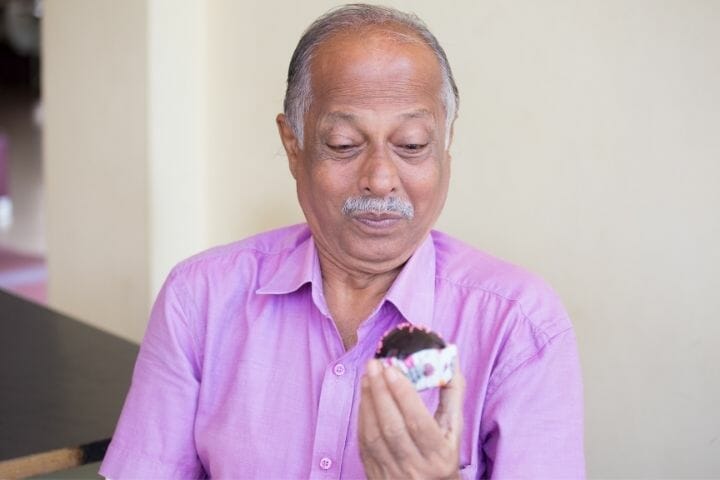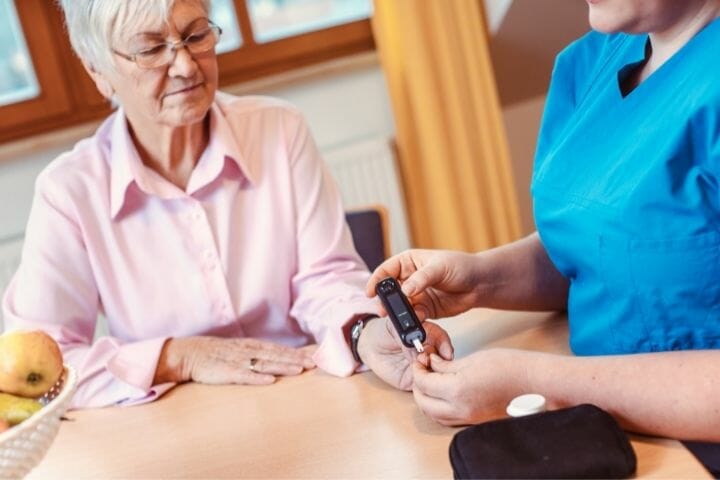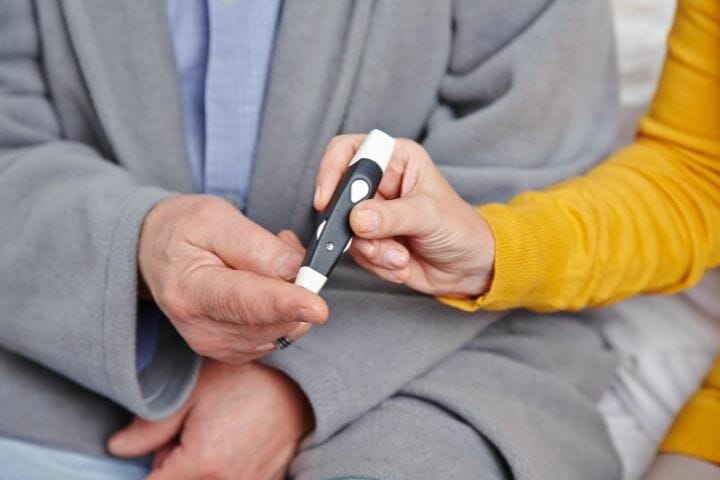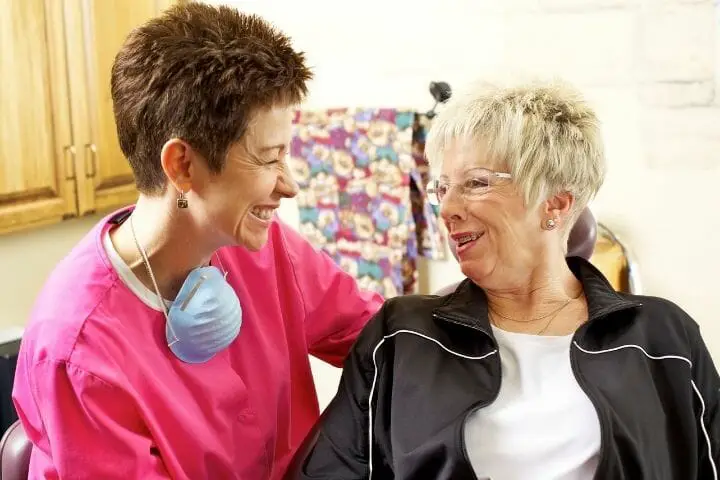Are you caring for a diabetes patient? Please read our detailed guide to know various tips to keep the blood sugar level of your diabetes patient under control.
Contents
Diabetes is a disease that occurs when the glucose level in your blood is too high.
It is a chronic disease that is commonly found in many older adults. The American diabetes association estimates that 1.5 million Americans are diagnosed every year, out of which the percentage of older adults is as high as 26.8%.

Diabetes is not 100 percent curable, but it can be managed by leading a healthy life, eating balanced food, and regular exercise. You can also lower the risk of diabetes through simple, everyday steps. The likelihood of success increases when an older adult receives support from a family caregiver.
So, if you are a caregiver of a senior person at your home, this article will guide you with some essential tips that will help you in managing diabetes.
You might like to read: How Have the Causes of US Deaths Changed Greatly Over the Past 100 Years?
What Is Diabetes?
Your body converts the food you eat into sugar(glucose), which is the primary energy source. The pancreas secretes the insulin hormone that helps get the glucose into the cells so that it can be used as an energy source.
But when your patient has diabetes, their body either doesn’t produce enough insulin, or their body cannot properly use the insulin produced. Consequently, there will be an accumulation of too much glucose in the blood, which can cause severe health problems.
What Are The Types Of Diabetes?
There are mainly two types of diabetes.
#1. Type 1 Diabetes
If your patient has Type 1 diabetes, his body produces little or no insulin. So, he needs to take insulin every day to stay alive.
#2. Type 2 Diabetes
If your patient has Type 2 diabetes, his body does not produce enough insulin or resists insulin. It mainly happens when he has a family history of diabetes or is overweight.
Sometimes physical inactiveness and other health problems can be the reason for Type 2 diabetes developing in your patient.

Why Is Diabetes Management Important?
Diabetes can affect many organs of your loved one. So, it’s essential to manage diabetes; otherwise, it may lead to health problems like heart disease, kidney disease, eye problems, nerve damage, gum disease, foot problems, and various others.
Again, if your loved one has Type 2 diabetes, they have a high chance of suffering from cancer or Alzheimer’s disease. The ADA has instituted the American Diabetes Month initiative to spread awareness about this chronic disease.
You might like to read: ADLs And IADLs – A Guide For Caregivers
How Can I Help My Patient In Managing Diabetes?
#1. Encourage Your Patient To Stay Healthy
One hour of daily exercise is essential for your elderly patient to lead a healthy life. It also helps in keeping the blood sugar levels within the normal range.
You can tell your patient to check their blood sugar level before and after exercise. Try to consult their doctor if they are going to choose a new exercise program.
#2. Make Sure Your Patient stays Hydrated
You should encourage your elderly seniors to drink caffeine-free and sugar-free fluids to stay hydrated. In my opinion, plain water is the best option to stay hydrated.
#3. Make Sure Your Patient takes Daily Medications
Your patient should take daily medications regularly and on time; otherwise, it may hurt their health.
#4. Monitor The Blood Sugar Level Regularly
Try to monitor the blood sugar level of your patient regularly. It helps you know which exercise, food, or medications work effectively.
#5. Find Ways To Minimize Stress
You can help your diabetic patient get rid of stress and depression as much as possible by engaging in constructive activities like gardening, walking, or breathing exercises.
#6. Make Sure Your Patient eats Healthy food
Your patient should eat balanced food to stay fit both physically and mentally.

You might like to read: The Evolution Of Medicine And Caregiving
Meal Planning With Diabetes
You need to make a meal plan for your diabetic patient to control the blood sugar level.
A good meal plan should include non-starchy vegetables like broccoli and spinach.
You should always focus on whole foods instead of processed food for your patient. Additionally, add sugars and refined grains like bread or rice and 2 grams of fiber per serving.
Carbohydrates in the food can raise the blood sugar level of your patient. But if you give food that is rich in carbohydrates, proteins, fat, or fiber to your patient, then the blood sugar level does not rise too quickly.
You should follow the counting carbs or plate method for your older adult to make meal planning easier. Let me discuss the two methods below.
#1. Counting Carbs
You should track how many carbs your older adult eats in each meal, snack, or drink and then set a limit for each meal. It will help keep the blood sugar level in control.
You can check the carb counting list or use a carb counting application to know the number of carbs in foods or drinks. You may also ask the doctor about how many carbs your older adult can eat each day and in each meal to keep the blood sugar level in control.
#2.Plate Method
The plate method is a simple way to ensure your patient gets enough non-starchy vegetables and protein while minimizing the foods containing high carbohydrates.
You can start the plate method with a 9-inch dinner plate and fill half of the plate with non-starchy vegetables. The non-starchy vegetables can include salads, cauliflower, cabbage, carrots, or beans. Then fill one-quarter of the plate with lean protein. The lean protein can consist of chicken, turkey, tofu, or eggs. Then fill the other quarter with carbohydrate foods like grains, rice, pasta, fruit, or yogurt. A cup of milk will count as carbohydrate food.
After completing the meal, your patient can choose water or take a low-calorie drink like unsweetened iced tea.

You might like to read: How Much Care Will You Need At Different Stages Of Life?
Diabetes And FootCare
If the blood sugar level of your senior is not under control, he may have poor or no feeling in his feet. He may not even realize about minor injuries.
Consequently, germs or fungus can get inside the minor cuts or cracks. Diabetes can even cause the skin to dry and the heels to crack.
Diabetes can lower the blood flow towards the feet of your elderly patient. That’s why cuts or sores may take a longer time to heal. Sometimes a bad infection never heals and may lead to gangrene.
When gangrene and foot ulcers do not get better even after treatment, the doctor might have to amputate the foot of your patient.
Sometimes nerve damage in your patient’s foot may lead to Charcot’s foot. It starts with redness, warmth, and swelling, and later, the bones on your patient’s feet may become stiff or break. Consequently, the feet become deformed.
So, as a caregiver, you need to take care of your senior loved one; otherwise, it may lead to severe problems.
How Can I Take Care Of My Diabetic Loved Ones Feet?
#1. Wash And Dry The Feet Daily
You should try to keep your elderly seniors’ feet regularly, but don’t soak the feet with water for a long time because it can cause excessive dryness.
Additionally, try to use mild soaps and warm water. After cleaning the feet, you need to pat a towel to dry the feet. Put some lotion or petroleum jelly on them but don’t put it in between the toes because it can lead to infection.
You need to be extra careful in the winter season because cold weather and central heating can cause the skin to become dry. Try to moisturize and keep the feet warm constantly.
#2. Try To Check The Feet Of Your Patient every day
You can set a specific time on a day and check their feet daily. Try to check the feet in good light so that you can check for dry or cracked skin, bruises, cuts, scratches, redness, and swelling.
#3.Protect Their Feet With Shoes And Socks
You should never allow your senior adult to go outside barefoot; otherwise, small rocks or pieces of glass may end up cutting the feet. Try to protect their feet with shoes or hard-soled slippers along with socks while going outside.
You can tell your patient to change their socks daily. You can advise them to prefer socks of natural fibers like cotton or wool. Some people also wear diabetic socks, which can improve blood flow and keep the feet dry.

You might like to read: Shocking Senior Nutrition Statistics: 7.3mn American Seniors Go Hungry!
#4. Take Your Patient Immediately To Doctor If You See Any Cuts On The Feet
If you observe any cuts, bumps, or sores on your patient’s skin, then it’s wise to take the patient to the doctor so that he can diagnose the seriousness of the condition.
Eye Complications With Diabetes
You should take your patient to an eye doctor every few months because high blood sugar levels can lead to eye problems.
Your patient may have had blurry vision for several weeks because of a change in meal plan or medicines. High glucose levels can change the fluid level of your patient’s eye. It may even cause swelling of some of the tissues in the eye.
It results in blurry vision. Well, you don’t need to be worried about it. Your older adult will see things normally when the blood sugar level gets closer to the normal range.
But if the blood sugar level of your patient remains constantly high, it can damage the blood vessels at the back of the eye. The damaged blood vessels can cause leakage of fluid or swelling in your patient’s eye.
You need to remember that most serious eye diseases start with blood vessel problems in the eyes of your diabetic patient.
Common Eye Diseases In A Diabetic Patient
Let me discuss four eye diseases that can be seen in your diabetes patient if the blood sugar is not within normal range.
#1. Diabetic Retinopathy
The retina is the last layer of the eye of your patient. Its work is to sense the light and turn it into signals so that you can see the world around you.
But, when the blood vessels in the retina get damaged, it can cause diabetic retinopathy. If the diabetic retinopathy gets worse, your patient will have severe vision problems.
#2. Diabetic Macular Edema
You use a Macula (part of a retina) for reading, driving, or seeing everyone. High blood sugar levels can cause swelling of the macula in your patient, which you can call diabetic macular edema. This disease can cause partial vision loss or complete blindness with time.

You might like to read: Americans With Disability Act – A Brief Guide For Caregivers
#3.Glaucoma
High blood sugar levels can damage your optic nerve (the nerve that connects the eye to the brain), which is called glaucoma.
#4. Cataract
The lenses inside the eye are always clear to have good vision. But your older adult may have cloudy lenses because of diabetes which you are called a cataract.
What Are The Best Ways To Keep Your Eyes Healthy?
- Try to manage your patient’s blood pressure, blood sugar, and cholesterol within the normal range.
- If your patient smokes, then try any possible ways so that your patient will quit smoking.
- Try to have a dilated eye exam of your patient once a year.
How To Tame A Sweet Tooth
There are various ways to tame a sweet tooth.
#1. Choose Fruit
You can give fruits to your patient. They are not only delicious but also packed with nutrition. It has few carbohydrates with no added sugar in comparison to processed food.
Try to give whole fruits to your seniors instead of juice because the flesh of the fruit contains fiber which helps in reducing heart disease and keeping the blood sugar level in control.
#2. Artificial Sweeteners
You can sometimes use a pinch of artificial sweeteners in your food. Artificial sweeteners usually have few carbohydrates and calories in comparison to sugar.
#3. Dark Chocolate
You can sometimes give dark chocolate to your diabetic patient. You need to remember that the higher the cocoa in the bar, the lesser the sugar content. Dark chocolate is also packed with healthy antioxidants, which are essential for controlling your patient’s blood pressure.

You might like to read: Benefits Of Magnesium As We Age
Wrap Up
Diabetes is a chronic disease. You need to always keep the blood sugar level under control to avoid eye diseases, foot problems, and various others.
I hope this article has given you helpful information, and please don’t forget to share the article with someone caring for a diabetes patient. You can ask any queries related to caring for diabetes patients in the comments section. I will be happy to answer your queries.
As always, if you love the content, please do not hesitate to share this article with those who are in need of similar information.
